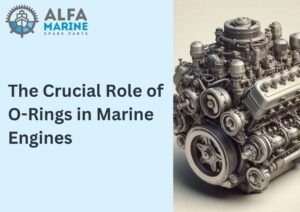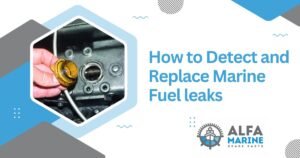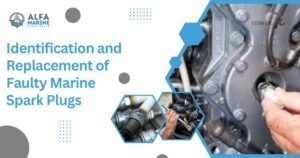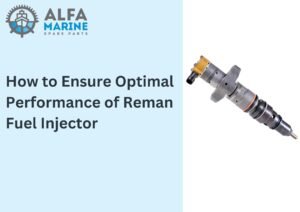A Hydraulic cylinder is the unsung hero of heavy machinery, crucial in powering a wide range of industrial and marine operations.
At Alfa Marin Spare Parts, we understand the vital role these components play in converting fluid power into mechanical force, enabling the efficient push, pull, and lift actions required by everything from commercial fishing vessels and marine cranes to construction and manufacturing equipment.
Our goal is to provide easy-to-understand tips that will help you stay safe while working with these powerful tools. Stay tuned as we dive into the essential safety tips everyone should follow when handling hydraulic cylinders.
What is a Hydraulic Cylinder?
It is a mechanical actuator that provides linear force through a linear stroke, powered by pressurized hydraulic fluid.
However, it is a crucial component in various applications requiring heavy lifting, pushing, pulling, and precise movements.
These cylinders are widely used in industries such as marine, construction, manufacturing, and agriculture due to their ability to handle substantial loads and operate under high pressures.
Components of a Hydraulic Cylinder:
- Cylinder Barrel: The main body that houses the piston and hydraulic fluid.
- Piston: A solid cylinder inside the barrel that divides the internal space into two chambers.
- Piston Rod: Attached to the piston and extends out of the cylinder, transferring the generated force.
- Seal Glands: Ensure the hydraulic fluid stays within the cylinder and prevents leaks.
- End Caps: Close off the ends of the cylinder and provide attachment points for mounting.
How It Works:
The basic principle behind a hydraulic cylinder’s operation is Pascal’s law, which states that pressure applied to a confined fluid is transmitted equally in all directions.
When hydraulic fluid is pumped into one side of the piston, it creates pressure that moves the piston and the attached rod.
However, this movement translates into linear force, which can be harnessed to perform various tasks like lifting heavy loads, moving machinery parts, and more.
Applications:
- Marine Vessels: Used in steering systems, hatch covers, cranes, and winches.
- Construction Equipment: Found in excavators, bulldozers, and loaders.
- Manufacturing: Integral to machine presses, injection molding machines, and assembly lines.
- Agriculture: Powering implements like plows, harvesters, and balers.
Hydraulic cylinders are essential for their ability to deliver powerful and precise movements, making them indispensable in modern machinery.
Their durability and efficiency make them a preferred choice for operations that require robust and reliable performance.
Why are hydraulic cylinders important?
First things first, let’s clarify what a hydraulic cylinder is. Picture this: it’s a tube-like structure that moves things in and out using fluid pressure. In simpler terms, think of it like a muscle for machines.
Powering Heavy Lifting
One big reason hydraulic cylinders are essential is their ability to lift heavy objects. Imagine trying to push your car with just your hands—pretty tough, right?
Well, hydraulic cylinders make it look easy by converting fluid power into mechanical force. So, they’re used in construction equipment like bulldozers and cranes.
Precision Matters
Ever watched a construction site and noticed how smoothly everything operates? That’s thanks to hydraulic cylinders.
Besides, they offer precise control over movements, ensuring everything goes exactly where it needs to be. This precision is vital for tasks that require accuracy.
Strength and Durability
Hydraulic cylinders are built to last. Made from strong materials like steel, they can withstand harsh conditions without breaking down. Whether it’s hot or cold outside, these cylinders keep working efficiently.
Versatility in the use of
You might think hydraulic cylinders are only for industrial use, but they’re everywhere! From elevators in buildings to farm machinery—these powerful components help make everyday tasks easier and more efficient.
Easy Maintenance
Maintaining hydraulic cylinders is straightforward. Regular checks and simple fixes can keep them running smoothly for years. Plus, at Alfa Marine Spare Parts, we offer all the spare parts you need to ensure your machinery stays in top shape.
So, there you have it! Hydraulic cylinders are key players in powering heavy lifting, offering precision control, ensuring durability, providing versatility in various applications, and requiring easy maintenance.
Furthermore, if you’re looking for quality components like A Hydraulic Cylinder or any other marine spare parts, remember Alfa Marine Spare Parts has got you covered!
Thanks for joining us today! Feel free to explore more on our website or reach out if you have questions.
How do you maintain the hydraulic system on a ship?
Maintaining a ship’s hydraulic system is crucial for its operation and safety. At Alfa Marine Spare Parts, we understand the importance of keeping every component in top shape, especially the hydraulic cylinders that play a vital role in your ship’s performance.
Regular Inspections
Inspect your hydraulic system regularly. So, look for signs of wear and tear, leaks, or unusual noises. Pay special attention to the hydraulic cylinders as they are key components.
Check Fluid Levels
Checking fluid levels is essential. Low hydraulic fluid can cause damage to the system. Ensure you use the right type of fluid recommended by your manufacturer.
Replace Filters
Filters keep contaminants out of the hydraulic fluid. Replace them according to your maintenance schedule to ensure smooth operation.
Monitor Hoses and Connections
Hydraulic hoses and connections should be tight and free from cracks or abrasions. Any damage can lead to leaks or failure.
Lubricate Moving Parts
Lubrication reduces friction and wear on moving parts within the hydraulic system, including the hydraulic cylinder.
Bleed Air from the System
Air trapped in the hydraulic system can affect performance. Bleed air from the system as required to maintain efficiency.
Test Pressure Settings
Ensure pressure settings are within specified limits for all components, especially critical ones like the hydraulic cylinder.
Following these steps will help extend the life of your ship’s hydraulic system and ensure safe travels at sea.
For more tips or quality spare parts, trust Alfa Marine Spare Parts – we’ve got you covered!
What is the main function of the hydraulic system?
The primary function of a hydraulic system is to transmit power through pressurized fluid to perform work.
This power transmission allows for the efficient operation of various machinery and equipment, enabling the control and movement of mechanical components with precision and force.
However, hydraulic systems are integral to many industrial applications, providing the muscle needed for tasks ranging from lifting and pushing to rotating and clamping.
Key Functions of a Hydraulic System:
Power Transmission:
- Force Multiplication: Hydraulic systems can amplify a small input force into a much larger output force, making it possible to lift heavy loads or exert significant pressure with minimal effort.
- Precise Control: The flow and pressure of the hydraulic fluid can be finely controlled, allowing for precise movements and also adjustments of mechanical components.
Energy Conversion:
- Fluid Power to Mechanical Power: The system converts the energy stored in hydraulic fluid into mechanical energy. This conversion is essential for driving various machine parts, such as cylinders, motors, and actuators.
Load Handling:
- Lifting and Lowering: Hydraulic systems are commonly used in equipment like cranes, lifts, and jacks, where they provide the force needed to lift and lower heavy objects safely and smoothly.
- Pushing and Pulling: They are also used in machinery that requires pushing or pulling actions, such as hydraulic presses and rams.
Motion Control:
- Linear Motion: Hydraulic cylinders provide linear motion, which is crucial for applications like extending and retracting arms in construction equipment and controlling rudders on ships.
- Rotary Motion: Hydraulic motors deliver rotary motion, used in applications such as driving conveyor belts, winches, and rotating machinery parts.
Applications:
- Marine: Steering systems, winches, and hatch covers.
- Construction: Excavators, bulldozers, and loaders.
- Manufacturing: Machine presses, assembly lines, and injection molding machines.
- Agriculture: Tractors, plows, and harvesters.
- Hydraulic systems are valued for their ability to deliver powerful, controlled, and reliable motion. Moreover, by utilizing pressurized fluid, these systems provide the force and control needed to perform complex tasks efficiently and effectively in a variety of industrial settings.
How to repair a hydraulic cylinder?
Whether you’re a hands-on woman who loves to tackle repairs or someone who’s just getting started with DIY projects, we’re here to help.
Today, I’ll guide you through the process of repairing a hydraulic cylinder. Don’t worry; we’ll keep it simple.
What You’ll Need?
Before starting, let’s gather some essential tools and materials:
– A wrench set
– Screwdrivers
– Pliers
– Seals and O-rings (specific to your hydraulic cylinder)
– Clean cloths
– Hydraulic fluid
Step-by-Step Guide
Step 1: Safety First!
Always start by ensuring your safety. Wear gloves and safety goggles. Make sure the hydraulic system is depressurized before you begin working on it.
Step 2: Remove the Cylinder
Disconnect the hydraulic cylinder from the machine. Use your wrench set to unscrew any bolts or fasteners. Place all parts in an organized manner so you don’t lose anything.
Step 3: Disassemble the Cylinder
Now, carefully disassemble the hydraulic cylinder:
1. Remove the rod end using pliers.
2. Take out any seals or O-rings.
3. Also clean each part thoroughly with a clean cloth.
Step 4: Inspect for Damage
Look closely at all components for signs of wear or damage:
– Check the seals and O-rings for cracks.
– Inspect the piston rod for scratches or bends.
– Examine the cylinder bore for any deformities.
Step 5: Replace Damaged Parts
If you find any damaged parts, replace them:
1. Install new seals and O-rings.
2. Ensure that all parts fit snugly but can move smoothly.
Step 6: Reassemble the Cylinder
Piece everything back together in reverse order:
1. Insert new seals into place.
2. Slide the piston rod back into the cylinder bore.
3. Securely fasten all bolts and screws using your wrench set.
Step 7: Test for Leaks
Once reassembled, reconnect your hydraulic cylinder to its machine and test it:
1. Slowly pressurize the system while checking for leaks.
2. If there are no leaks, operate it under normal conditions to ensure everything works correctly.
Tips & Tricks
Keep a clean workspace; dirt can cause problems in hydraulic systems.
Regular maintenance can prevent many common issues with hydraulic cylinders.
Conclusion
Repairing a hydraulic cylinder may sound intimidating, but with this simple guide from Alfa Marine Spare Parts, you’ll see it’s quite manageable! Remember, taking care of your equipment saves time and money in the long run – plus there’s nothing more satisfying than fixing something yourself!
For more tips on marine spare parts or maintenance guides, visit us at [Alfa Marine Spare Parts].
Tips for Choosing the Right Hydraulic Cylinder
When it comes to machinery, making sure you have the right parts is crucial. One of those essential parts is a hydraulic cylinder. But how do you choose the right one?
Here at Alfa Marine Spare Parts, we understand that this can be a daunting task, especially if you’re new to the world of machinery. So, we’ve put together some simple tips to help you pick the perfect hydraulic cylinder.
1. Understand Your Needs
Before diving into options, it’s essential to understand what your machine requires. Is it for lifting heavy weights or simply moving components? Knowing your specific needs will narrow down your choices.
2. Consider the Cylinder Type
Hydraulic cylinders come in different types:
**Single-acting cylinders**: These use hydraulic pressure for movement in one direction.
**Double-acting cylinders**: These utilize pressure in both directions for more complex tasks.
Understanding these differences is key to choosing the right type for your project.
3. Check the Size and Stroke Length
The size of the cylinder and its stroke length are pivotal. The stroke length refers to how far the cylinder extends and retracts. Make sure it matches your requirements to avoid performance issues.
4. Examine Material and Build Quality
Durability matters! Look at what materials are used in constructing the cylinder. High-quality steel or aluminum often ensures longer life and better performance.
5. Inspect Mounting Options
Different machines require different mounting styles – flange, trunnion, or clevis mounts are common types. Ensure that your chosen hydraulic cylinder is compatible with your equipment’s mounting setup.
6. Pressure Ratings Matter
Know the maximum operating pressure of your system before selecting a cylinder. Overloading a hydraulic cylinder beyond its pressure rating can lead to failure and safety concerns.
7. Compatibility with Other Parts
Basically, ensures that all components of your hydraulic system work together seamlessly by verifying compatibility between existing parts and your new hydraulic cylinder.
Lastly, Choosing the right hydraulic cylinder doesn’t have to be complicated! By understanding your needs, considering different types, checking size and quality, examining mounting options, knowing pressure ratings, and ensuring part compatibility, you’ll make an informed decision with ease.
For top-quality hydraulic cylinders and expert advice, turn to Alfa Marine Spare Parts – we’re here to help every step of the way!
Frequently Asked Questions
What are the common causes of hydraulic cylinder failure?
Seal degradation, fluid contamination, improper installation, overloading, and inadequate maintenance contribute to hydraulic cylinder failures.
How can I ensure the safe operation of hydraulic cylinders?
Follow safety tips including regular inspection for leaks, using proper fluid, avoiding overloading, adhering to manufacturer guidelines, and implementing safety measures like pressure relief valves.
What maintenance tasks are essential for prolonging hydraulic cylinder life?
Essential tasks include checking for leaks, inspecting rods and seals, lubricating moving parts, flushing and replacing fluid, and conducting load tests.
How do I troubleshoot common issues with it?
Troubleshoot by checking for leaks, inspecting rods, verifying fluid levels, examining control valves, and consulting manuals or technicians for complex problems.
What are the safety precautions to observe during hydraulic cylinder maintenance?
Observe safety precautions such as depressurizing systems, wearing PPE, securing systems, avoiding working under loads, and providing training on safe practices.
Final Thought
Hydraulic cylinders are crucial for powering heavy machinery across various industries, converting hydraulic energy into mechanical force for lifting, pushing, and precise movements.
To ensure optimal performance and longevity, invest in high-quality cylinders, conduct regular maintenance, and follow safety protocols.
So, at Alfa Marin Spare Parts, we emphasize the importance of imperishability and reliability in hydraulic systems, helping you achieve efficient and safe operations in even the most demanding environments.







